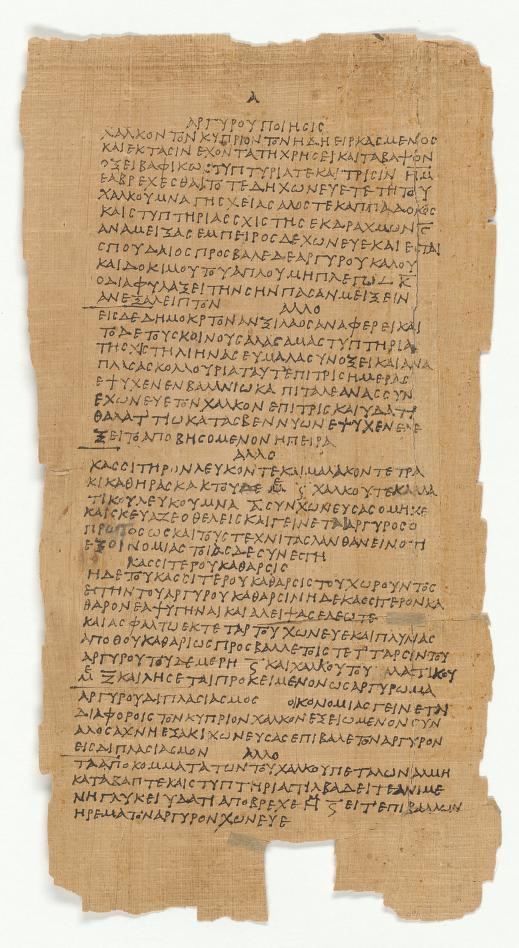Recreating History?
The Stockholm and Leyden Papyri
Greco-Egyptian Chemical Documents From the Early 4th Century AD

| In a nutshell: The Papyrus Graecus Holmiensis (also known as the Stockholm papyrus) is a collection of craft recipes compiled in Egypt c. 300 AD. It is written in Greek. The Stockholm papyrus has 154 recipes for dyeing, colouring gemstones, cleaning (purifying) pearls, and imitation gold and silver.[1] Certain of them may derive from the Pseudo-Democritus. Zosimos of Panopolis, an Egyptian alchemist of c. 300 AD, gives similar recipes. Some of these recipes are found in mediaeval Latin collections of technological recipes, notably the Mappae clavicula. Leyden papyrus X derives from the same (or very similar) sources, and is written in a similar (possibly the same) hand, using chemically identical ink.[2][3] The Stockholm papyrus and Leyden papyrus X were both found in Thebes by Giovanni Anastasi, who donated the Leyden papyrus to the Dutch government in 1828 and the Stockholm papyrus to the Swedish government in 1832. The Stockholm papyrus was first published by Otto Lagercrantz in 1913. Whereas Leyden papyrus X deals with metallurgy, the Stockholm papyrus deals with gems, pearls and textile dyeing.[4] From Wikipedia, the free encyclopaedia |
So, a set of very ancient recipes for producing colour. The parts that interest me the most are the recipes in the Stockholm Papyri for making dyes for textiles. These are the oldest written examples for dye recipes to be found (so far). The whole document can be found here.
Included are various recipes for making an inexpensive purple dye. Purple was an enormously expensive colour obtained from various natural, foraged substances and also from a particular gland obtained from murex molluscs at that time (and still today, and it’s still very expensive!) and was only worn by the very, very rich. It could be said that these recipes were a way of producing expensive looking cloth from readily available ingredients. What we might today call ‘fakes. And the Romans certainly liked their purple so there was a market waiting.
Now and again, a recipe used cryptic language for ingredients, perhaps as a of restricting success to those who were somehow “in the know.” For example; To write in letters of gold without using gold, several recipes call for the bile of river tortoises or goats. Mother’s milk and the urine of a young boy are also intermittently called for . And to add to any confusion it is highly probable that these recipes were copied down by those that knew nothing about the dyeing process and so missed vital information; or perhaps the methods were so well known that little explanation was needed.
My original research into the papyri was to be part of a larger project incorporating dyers from around the globe with a goal of presenting our results at the Dyes in History and Archaeology Conference in 2022. Unfortunately this was not to be so I present my experiments and results here.
None of the recipes were straightforward and most involved searching for obscure ingredients, looking up chemical formulas, finding alternatives where possible, substituting where the original plant or chemical just could not be sourced. Some required waiting for plants to grow, mature, flower and seed before attempting to recreate the elusive purple. There was also the added complication that a lot of the recipes made little sense with incomprehensible weights and measures lost to time and few had understandable directions. All in all, a major undertaking. I chose to try to recreate just two of the recipes; Recipe 113 and Recipe 132.
